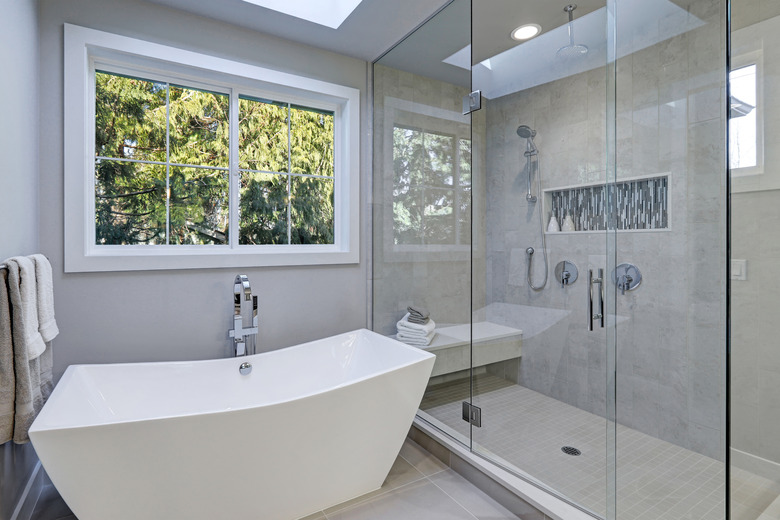How To Remove Calcium Deposits From Pipes
A clogged pipe is never fun, and while some blockages are easy to clear, others can leave homeowners scratching their heads. Removing calcium deposits in pipes falls into the second category. Depending on the type of pipes you're looking to clear, there are a couple of surefire methods to banish those calcium deposits.
Calcium deposits form when hard water (water high in minerals, like calcium, magnesium, or potassium) creates a buildup inside the pipes over time. Calcium deposits form in any pipe through which hard water moves. That means they can form as easily in your shower as they can form in the water supply to your home.
How to Tell if You Have Hard Water
How to Tell if You Have Hard Water
If you're not sure whether you have hard water, look for a film on your skin after showering or white stains on your dishes or inside your toilet. That could be lime scale, which is proof that your water is packing a hard mineral punch. You can also easily test for hard water yourself at home without buying a water testing kit.
Empty and clean a plastic bottle with a sealable lid. Fill the bottle halfway with the water you want to test. Add 1 teaspoon of dish soap to the bottle of water. Seal the lid and shake the bottle vigorously. Evaluate the results. If there are lots of bubbles and the water is clear, you have soft water. If there are few to no bubbles and the water is cloudy, you have hard water.
If you suspect hard water is causing calcium deposits in your plumbing, it's important to address the problem quickly. Calcium deposits in pipes can cause more damage than just annoying clogs, slow-moving drains, and a sluggish water supply. Calcium deposits cause pipe corrosion over time. If left unaddressed, these corroded pipes will need to be replaced, and surprise plumbing expenses aren't easy on anyone's budget.
How to Remove Calcium Deposits From Pipes
How to Remove Calcium Deposits From Pipes
You can attempt to remove calcium deposits yourself. Products like CLR are available to homeowners to solve problems just like this. Another method of getting rid of smaller calcium deposits in places like the toilet or sink can likely be accomplished with items already in your home.
Sprinkle 1 to 2 cups of baking soda down the pipe or drain. Let the baking soda sit for 30 minutes to give it time to thoroughly adhere to the moist inner surface area of the pipe. Pour 1 to 2 gallons of white vinegar down the drain or pipe. Go slowly, using a funnel to help minimize spills. Be mindful that you're creating a chemical reaction. When the vinegar interacts with the baking soda, it will foam up tremendously, and in theory, it will strip the excess mineral buildup from your pipes.
After the foam has subsided, run 1 to 2 gallons of hot water down the drain or pipe. Repeat no more than three times. If the drain is still clogged, you will need to contact a professional.
How Plumbers Remove Calcium Deposits From Pipes
How Plumbers Remove Calcium Deposits From Pipes
Bigger calcium deposits in trickier places (like your home's water supply, for example) won't be solved with a simple DIY solution. Contact a plumber who will use one of two methods to break up and remove the calcium deposits for good.
Hydrojetting is a popular method among plumbers. As the name implies, plumbers who offer hydrojetting services use a powerful jet of water to blast mineral deposits out of your pipes. Expect to pay between $250 and $600 depending on the location of the clog and its severity.
Chemical removal is another option for removal. Just as you can buy CLR, an array of chemicals is available to plumbers looking to remove calcium deposits from pipes. While they have access to more heavy-duty chemicals and the wherewithal to use them wisely, the best plumber will tell you that removing the calcium deposits from your pipes won't keep them from coming back.
Preventing Calcium Deposits From Forming
Preventing Calcium Deposits From Forming
There are a few solutions worth exploring when it comes to permanently stopping calcium deposits from forming. The first is to replace all of your metal pipes with plastic piping, which is completely resistant to mineral deposits. Replacing your pipes is costly, and if you aren't up for it, there's another alternative: investing in a water softening unit to reduce the number of minerals in the water.
References
- Rocket Plumbing: Calcium Build-up in Your Drains and Pipes? Here's How To Fix It
- Advantage Water Conditioning: How Do I Descale My Water Pipes?
- Roto-Rooter Plumbing & Water Cleanup: How to Remove Calcium Buildup in Drains and Pipes
- U.S. Geological Survey: Hardness in Water: Lime Scale Buildup Inside a Water Pipe
- Centers for Disease Control and Prevention: Drinking Water Pipe Systems
- U.S. Environmental Protection Agency: Secondary Drinking Water Standards: Guidance for Nuisance Chemicals
- Affordable Plumbing, Heating & Air: The Truth About the Costs of Hydro-Jetting
